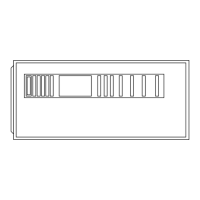10
30
• Inspect all flue gas passages, burners, heat exchangers, cou-
pling box(es), and inducer assembly.
• Inspect all combustion-air and vent piping inside structure
and vent pipe termination outside the structure.
• Check gas pipes leading to and inside of your furnace for leaks.
• Inspect and clean the blower motor and wheel.
NOTE: The inducer and blower motors are pre-lubricated and
require no additional lubrication. These motors can be identified
by the absence of oil ports on each end of the motor.
• Inspect and change or clean air filters(s) if necessary.
• Inspect all supply- and return-air ducts for obstructions, air
leaks, and insulation. Remedy any problem when necessary.
• Inspect the return-air duct connections(s) at the furnace to en-
sure it is physically sound, sealed to the furnace casing, and
terminates outside the space containing the furnace.
• Inspect electrical wiring, connections, and components for
loose connections.
• Perform an operational checkout to determine whether your
furnace is working properly and if it requires adjustments.
• Inspect all condensate drain tubes and condensate trap assem-
bly for leaks. The condensate removal system should be cleaned
annually by a qualified service agency. Refer to the Service and
Maintenance Instructions for further information.
• Examine the physical support of the furnace. Support should
be sound with no cracks, sagging, gaps, etc. around the base.
• Check furnace for any obvious signs of deterioration.
BEFORE YOU REQUEST A SERVICE CALL
If your furnace is not operating or not performing properly,
you may save the expense of a service call by checking a few
things yourself before calling for service.
NOTE: Record the LED status code BEFORE removing the
blower access door or turning off 115-v power to the furnace.
Removing the blower access door or turning off the 115-v pow-
er will end the LED status code display and erase the code from
the control’s memory.
FOR INSUFFICIENT AIRFLOW:
• Check for dirty air filter(s).
• Check for blocked return-air or supply-air grilles throughout
your home. Ensure they are open and unobstructed.
If problem still exists, call your dealer for service.
IF FURNACE FAILS TO OPERATE:
Follow this checklist step by step, advancing to the next step
only if furnace fails to start.
• Check thermostat for proper temperature. Is thermostat set
above room temperature?
• Is thermostat set on HEAT?
• Check fuses and circuit breakers. Is electrical supply on?
• Is manual shutoff valve in gas supply pipe in open position?
(Follow start-up procedures if you open gas valve.)
NOTE: Turn off electrical supply before continuing with
checklist.
• Is control switch on gas valve in ON position? (Follow start-
up procedures if you must reset switch to ON position.)
• Check manual reset flame rollout switch located on the burner
box. (See Fig. 2.) if furnace has experienced high temperature
conditions, this switch will shut off the furnace. Reset it by
pushing the button on the switch. If it trips again, shut down the
furnace and call for service. See “Shutting Down Your Furnace”
section in this manual.
• Check for obstructions around the vent termination.
If the furnace still fails to operate, call your service representa-
tive.
For your convenience, record the furnace product and serial
numbers on back page. Should you ever require service, you
will have ready access to the information needed by your ser-
vice representative.
This furnace has a light-emitting-diode (LED) status code dis-
play to aid the installer, service technician, or homeowner while
installing or servicing the unit. The LED code can be seen by
removing the main furnace door and viewing the LED through
the view port in the blower access panel.

